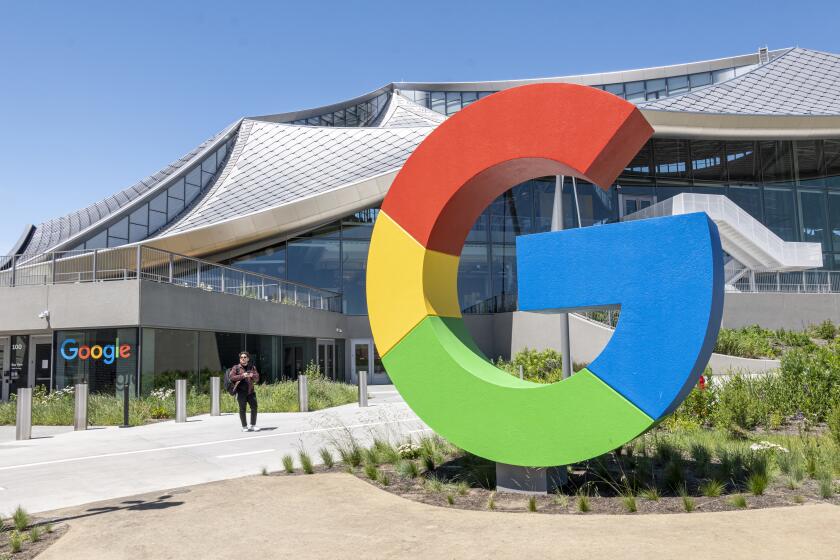You don’t need to own an iPhone for the government lawsuit against Apple to benefit you

- Share via
Last month, the Department of Justice filed its long-awaited antitrust suit against Apple, accusing the company of monopolizing the smartphone market. This makes Apple the last of the U.S.-based tech giants to face a major monopolization lawsuit from a federal agency. (Google also faces one from the Justice Department; Facebook and Amazon have been sued by the Federal Trade Commission.)
These suits make claims under Section 2 of the Sherman Act, an 1890 statute that makes it unlawful to obtain or maintain a large degree of market power through exclusionary and unfair practices. The government’s thoughtfully targeted case against Apple could, in the long term, give consumers substantially more choices when it comes to digital platforms.
Consumers may see lower prices on app subscriptions and purchases if the Department of Justice succeeds in its lawsuit against Apple, consumer advocates said.
In its complaint, the government makes a strong argument that Apple has used its market power over the iPhone to suppress competition through a two-pronged strategy: one, limit interoperability (i.e. compatibility) between Apple and outside operating systems, such as Google’s Android, and two, make non-Apple products work poorly on the iPhone. According to the Justice Department, this conduct has harmed consumers not only by degrading iPhone users’ experience but also by making it hard for other smartphones to compete with Apple. Without strong competition, quality goes down, price goes up and innovation lags.
The other major tech lawsuits raise similar consumer welfare concerns. But this one uniquely takes on the market power wielded by a company as a technological ecosystem — a one-stop virtual shop where users can communicate, play, watch, listen and buy.
Consumers have a love/hate relationship with these ecosystems. We love them when they make our lives easier, which they sometimes do because we need shortcuts to navigate a virtual world rife with information overload. Apple and other companies satisfy that desire by providing an ecosystem where products can be accessed with a single password and are, theoretically, curated for quality and safety. You can iMessage an image from your Apple photo library to a friend while streaming Apple Music to your AirPods. If your friend likes the photo, you get a text alert on your Apple Watch. These transactions are protected by an up-swipe and a glance from your face.
The possible entertainment industry deal poses big questions about protecting workers and consumers.
But sometimes we hate ecosystems. They can be akin to living in a fishbowl instead of an ocean, trading in the variety of a far larger world for simplicity. The biggest obstacle to leaving the fishbowl is the cost of trying something else. If you want to stray from Apple, you may have to learn a whole different interface, give up apps you like, reenter your data, track new passwords — and potentially spend thousands to replace your phone, watch, laptop (and so on). These switching costs give Apple market power to raise prices or degrade the quality of products without fear of consumers turning away.
In addition, the ecosystem structure creates a 360-degree view of our spending habits, likes and dislikes, and relationships. This data is extremely lucrative for companies and can seem futile for consumers to try to safeguard. When Apple changes its privacy policy with a take-it-or-leave-it update to lengthy and confusing terms of service, “leave it” doesn’t feel like a real option.
For decades, the enforcement of antitrust law has been too easy on company ecosystems. It has, for example, been tolerant of “non-horizontal” mergers between companies that do not directly compete to sell a product to consumers. Regulators let Apple buy Siri, Shazam, Beats, Dark Sky (which was shuttered in favor of Apple Weather) and Texture (which became Apple News+), to name a few of Apple’s more than 100 acquisitions since the iPhone’s release.
The assumption was that mergers between non-horizontal firms do not reduce competitive choices for consumers, at least not in the short term. But that approach has ignored the cumulative effects. As more properties accumulated under the Apple brand, it became harder for competitors to offer a viable alternative because they would have to enter dozens of markets at once.
From railroad tycoons to tech titans, the Golden State is a frequent cosigner on national antitrust lawsuits.
This problem is not new. A political cartoon from the turn of the 20th century depicted the monopoly power of Standard Oil as an octopus with tentacles in oil production, shipping and railroads. Apple may be the octopus monopolist of our time, just with 100 legs instead of eight.
In addition, Apple and other companies may have felt emboldened by court decisions from the last two decades stating that companies have only limited duties to deal with their competitors, giving tech platforms some cover to limit interoperability with outside products. But antitrust law does make refusals to interoperate illegal when they are designed to exclude competitors.
The Justice Department’s suit argues that Apple has blocked “super apps” that could serve as a bridge between platforms with the intent to keep consumers locked in. It also alleges that Apple has designed the iPhone to be nearly incompatible with wearables that would compete with the Apple Watch so as to add another expensive piece of hardware you must replace to leave its world of products. And Apple is accused of degrading competitors’ products, especially messages from Android phones, to create the impression that anything not made by Apple is inferior — that the world outside the fishbowl is scary and filled with green bubble texts.
These arguments tell a very plausible story of monopolization. It suggests product design motivated more by Apple maintaining market share than by taking care of consumers and competing for their loyalty. Apple will offer a counter-story, likely consistent with previous claims that these choices increase the quality and privacy of their products. Much of the case will turn on whether the company’s justifications reflect the real reasons behind its design choices.
Ultimately, the case invites the federal courts to answer a more fundamental question raised by today’s economy: Should consumers have more freedom to choose their digital environments and move between fishbowls? The answer should be yes.
Rebecca Haw Allensworth is an antitrust professor at Vanderbilt Law School.
More to Read
A cure for the common opinion
Get thought-provoking perspectives with our weekly newsletter.
You may occasionally receive promotional content from the Los Angeles Times.









